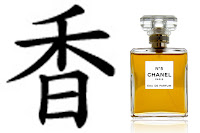
Encyclia radiata (or Prostechea radiata, as it’s now called) is one tough orchid plant. Last fall my plant was attacked by some insect cooties that nearly did it in. Once I discovered the problem, I treated the plant to get rid of the pests, a violent treatment that was designed to kill or cure. The poor plant was doused with nasty chemicals, painted with neem oil, and put outside in temperatures that hovered somewhere around freezing. During the coldest part of the winter, it sat in quarantine in the garage with no water or light for several months. In early March it went outside again, once more in cold temperatures. Then one day it started putting out flower buds.
The plant is now healthy, growing profusely, and blooming. It's in a place of honor on the kitchen counter, sporting a spray of lovely greenish-white flowers with purple-striped lips shaped like scallop shells, pumping out its amazing perfume. It’s a rich, vanilla-based fragrance with heaps of cinnamon, orange-y citrus, and a bit of indole beneath it all. Mostly, though, it’s a cinnamon-flavored dessert with some odd notes that are hard to describe because they’re unique.
As soon as as I smelled it, I considered making a perfume to honor this wonderful little plant. I’m thinking I’d call it Flor Conchita (little shell flower), which is its common name in Mexico, where it grows wild.
I never cease to be amazed by all of the serendipitous coincidences in perfume making and perfume sampling. The very day that my Conchita was blooming - I tried an extremely rare vintage Guerlain called Dawamesk, which contains indolic flowers and vanilla, and dries down to a base with a significant cinnamon note. I was standing in the kitchen when I smelled something that I thought was an unusually strong current of Dawamesk sillage, but it was not coming from my arm. I quickly traced it to the little orchid plant on the counter. I sniffed back and forth between my arm and the flowers, and the more I sniffed, the more I realized that the perfume and the orchid smelled shockingly similar. I’m blown away by the similarity between the scent of Encyclia radiata flowers and Guerlain Dawamesk. It’s almost enough to make me believe in the Jungian idea of synchronicity. It’s certainly enough to make me think that a perfume inspired by the orchid would pretty much amount to a remake of Dawamesk. Maybe that wouldn’t be such a bad thing.























